Top 25 Most Popular Greek Christmas Foods & Desserts
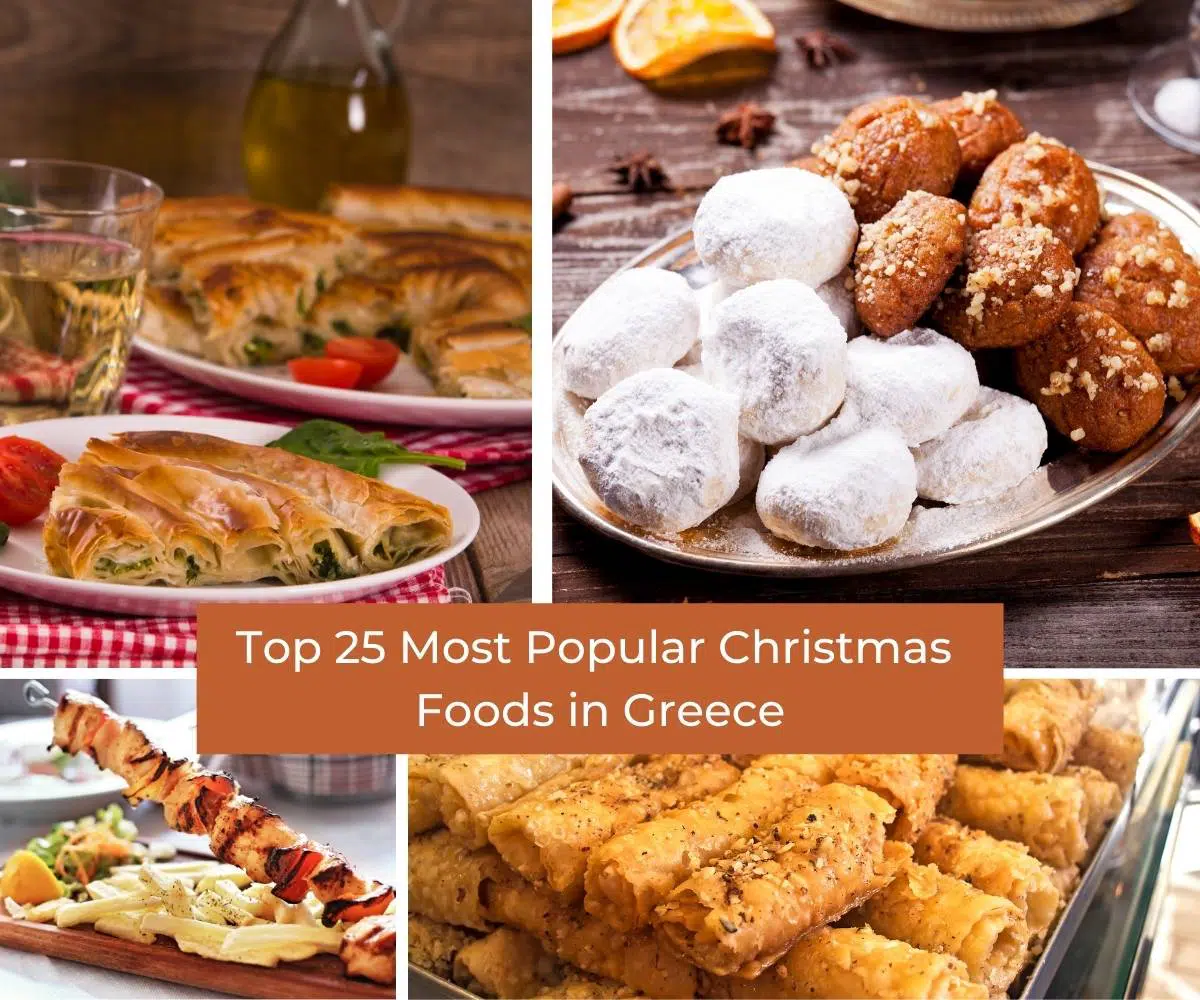
Christmas has been all about religious traditions in Greece, though things have changed in recent decades. Still, many traditional foods have managed to stay intact during the ubiquitous family Christmas table that takes place in Greece on the night of Christmas Eve. It’s also worth mentioning that for those who follow the Christian Orthodox religion, Christmas Eve is when they break their one-and-a-half-month long fast as well!
There’s no doubt that the Christmas table is full of mouthwatering entrees, warming main dishes, and of course, lush desserts. So, naturally, each region in Greece has its own traditions regarding the dishes that they serve. The most prominent typical food is pork cooked in various ways and with different sides and ingredients. It’s actually quite common to break a fast with pork and meat in general in Greece, so this tradition has prevailed through the centuries!
As far as desserts are concerned, you’ll notice from our extensive list below that they are centered around dough, honey syrup, and almonds. They surely are the spotlight of the Christmas table, with melomakarona and kourabiedes being the most marvelous Greek Christmas desserts.
Moreover, all these dishes mentioned in our list below are meant to bring families together and be enjoyed with one’s family and friends. This is why most of the foods are served in large portions so everyone can enjoy every single thing on the table! It’s truly a fantastic time being a part of such a table. The added benefit of experiencing it is that you definitely leave full and satisfied with the delicious treats consumed and the lively conversations shared.
Let’s take a look at the most popular Greek Christmas foods and desserts.
1. Pork and Celery Stew

Pork and celery stew is probably the most traditional main dish that is served on Christmas Eve. It’s heartwarming and quite lemony as it has a particular lemon and egg sauce typically used in various Greek foods.
Apart from many celery leaves, it also contains a lot of garlic and leeks cooked along with the pork. These ingredients give the meat an herby flavor that is counterbalanced with the zingy lemon sauce. As you may have noticed, there are no complicated ingredients to make this dish, and that’s simply what makes it so delicious!
2. Rooster with Tomato and Red Wine Sauce

You can think of this as the Greek version of the French “Coq au Vin.” This dish can be found mainly on the Christmas tables of the Cyclades island complex, and primarily the islands of Paros and Naxos.
During the preparation of this dish, the rooster is first seared. Then it’s boiled, along with onions, garlic, red wine, fresh tomatoes and tomato paste, and of course the secret ingredients: cinnamon, nutmeg, cloves, and allspice! Indeed, those ingredients are not just for desserts!
After the rooster is cooked, it’s served over thick pasta, and graviera cheese is grated right over it. As you can imagine, it’s a very warming dish and perfect for Christmas Eve dinner!
Check out this story for more traditional foods from Naxos and Paros.
3. Oven-Roasted Stuffed Pork

You must’ve surely realized by now that pork is a centerpiece at the Christmas table in Greece.
This recipe is actually a Greek version of the Western stuffed turkey. The stuffed pork is made of pork belly, shaped like a cylinder, and loaded with chestnuts, prunes, onion and garlic, orange zest, oregano, and thyme. It’s another very fragrant main dish that is mostly a part of Central Greek Christmas Eve traditions.
4. Gourounopoula

If you guessed that this is another pork recipe, you are very right! Indeed, “Gourounopoula” can be directly translated to “oven-roasted pork” without stuffing. However, the English description doesn’t mention that this is a melt-in-your-mouth type of oven-roasted pork.
The meat is first brushed with a simple honey-mustard mixture. Then it’s placed over thickly cut lemony and garlicky potatoes to be roasted for two and a half hours! It is a moderately low and slow process, but the end result is so very worth it.
5. Kontosouvli

Kontosouvli is still pork, but this time it’s a mixture of the fatty pancetta and pork neck used for the recipe. Moreover, the meat sits in a marinade of white wine vinegar, olive oil, red pepper flakes, coriander seeds, paprika, and thyme for about six to eight whole hours! Then it’s even further flavored by brushing honey mustard over the pieces of meat.
The exciting part about this recipe is that it’s ideally cooked over an open coal fire for about four and a half hours. First, it’s wrapped in tin foil and then uncovered to get the perfect crust. The end result is “kontosouvli” that melts in your mouth when you bite into it but still retains that satisfyingly crispy exterior.
6. Patsas

The best way to describe “Patsas” is that it looks like a soup that is also considered one of the most revitalizing and strengthening of its kind.
It’s made out of a veal’s shank and tripe placed in a simple marinade of lemon and salt for about a whole night. Then, the meat is washed and goes through a boiling process that lasts about two and a half hours. After that, the shank and tripe are cut into tiny pieces served with the water they were boiled in.
Moreover, a mixture of puréed garlic and wine vinegar called “skorthostoumpi” is also placed over the soup. Some people also like adding red pepper flakes over the top for more spiciness. Traditionally, this is a dish that was, and still is, served after hours when someone has spent a long night drinking. But it’s also considered a Christmas Eve food in northern parts of Greece.
7. Spiced Pork Sausages

Homemade spiced pork sausages are a delicacy prevalent in the areas of Evia and Peloponnisos during Christmas. Some might think that it’s pretty challenging to make sausages on your own. Still, traditional recipes have their tips and tricks to make the job reasonably easy.
The sausages are usually prepared a few days before Christmas Eve, and their unique ingredients include nutmeg and orange zest. Clearly, these ingredients aren’t just reserved for desserts!
8. Goat Soup

Goat soup or “boiled goat” is a dish primarily enjoyed in the northern parts of Greece during the winter and Christmas Eve periods. It’s probably the simplest soup, since it only contains meat, potatoes, carrots, celery leaves, bay leaves, salt, and pepper.
The flavor of the meat and the bay leaves are the two things that make the whole dish so tasty and hearty to be enjoyed during that usually cold December day.
9. Greek Cabbage Rolls

Greek cabbage rolls are also known as “lachanontolmàdes.” They are usually filled with minced beef and pork, rice, carrots, and onions. The cabbage leaves are boiled to become softer, then the filling is placed in the center of each leaf, and the rolling begins!
The more traditional grandmas know how to speed up the rolling process, as it can be a bit more difficult because the cabbage leaves can split open quite easily. Finally, the rolls are served with a thick egg-lemon sauce (avgolemono) poured over them, along with freshly ground pepper. A flavorful, filling, and warming dish!
10. Pikti
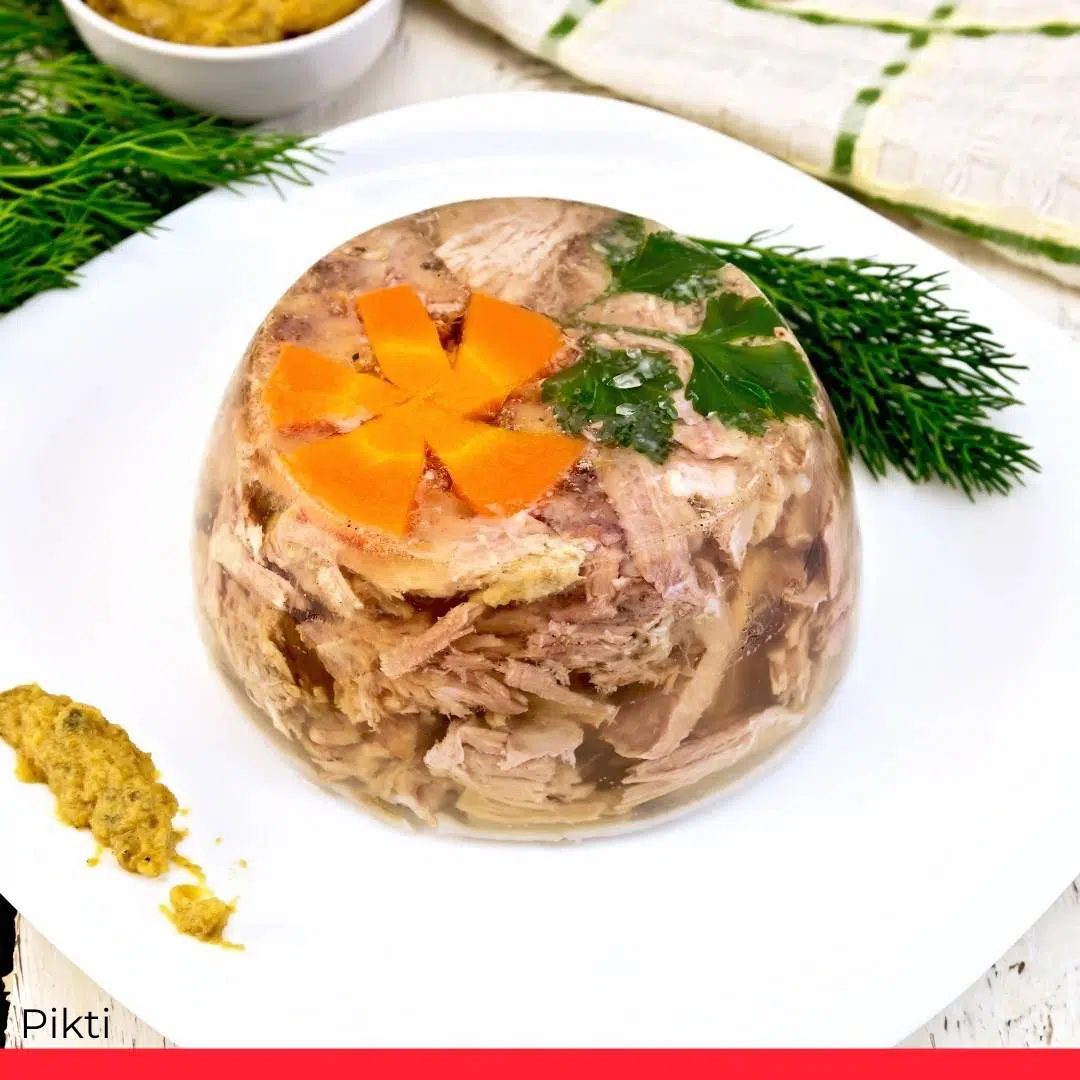
Pikti is a dish of an acquired taste, and it’s served mainly on the island of Samos on Christmas Eve. In essence, it’s a pork-vegetable-garlic-lemon soup that is turned into jelly due to the pork’s fat! The soup is placed in a rectangular dish and is stored in the fridge for 24 hours. After that, it’s served sliced on a big platter as an entrée for the whole family to share.
11. S’kotaria (Fried Liver)

S’kotaria is basically fried liver with oregano and lemon. This is a traditional dish that is served in Crete during most celebrations such as Easter and Christmas Eve. It’s effortless and quick to make, so the Cretans usually refer to it as a “meze” that goes well with wine or raki, a traditional strong Cretan drink.
12. Msoura

Msoura is a traditional dish that is mainly served in the region of Salonika. It’s a dish composed of three types of meat: chicken, pork, and veal. The chicken is stuffed with chicken liver, chestnuts, rice, and raisins. It’s placed over pork fat and veal to be roasted in the oven for about six hours! The result is actually quite delectable and filling, and perfect for wintertime in the north of Greece!
13. Bampo

Bampo is a traditional type of sausage that is made in the area of Thrace. Notably, along with the meat stuffed in a pork’s intestine, rice and allspice are also placed there. It’s a traditional delicacy that is also considered to be no-waste. Essentially, it’s meant to use all pork parts that were not used in other pork-related recipes served on the Christmas Eve table.
In any case, we should also mention that the name “Bampo” means “grandma,” which was the most esteemed and wise person in the family. However, it’s still unclear how that name turned into another delicious Christmas dish.
14. Greek Meat Pie

As you might already know, pies in Greece are different from pies in most Western countries. That is precisely the case with the traditional meat pie served as a shareable dish for the Christmas Eve table. Crispy phyllo encases chuck and pork mince, along with tomato, garlic, onions, rice, parsley, dill, and of course, a bit of cinnamon.
This last ingredient deepens the flavor and meshes everything together, creating a festive medley of flavors in your mouth! It’s a dish totally worth trying.
15. Spanakopita

Spanakopita is the very classic Greek spinach-phyllo-feta cheese pie. Of course, since it’s such a ubiquitous type of dish, it can’t go missing from the Christmas Eve table either! People in different areas of Greece have their own special ways of making spanakopita. That, of course, includes the spiral-formed spanakopita.
The different pie presentation isn’t just for looks; the spiral shape ensures even more crispiness of the phyllo than the usual rectangular spinach pie, adding another textural element to the tasting experience.
16. Pork Omàtes
The Sfakian “omàtes” from Crete are much like bampo and regular sausages. Again, they are handmade and are prepared days before the Christmas Eve table.
You might be wondering, “what makes this dish so special, then?” The answer is quite simple: It’s the raisins! They genuinely transform the flavor profile of the regular sausage, along with the liver stuffed in there as well. Omàtes truly is one of those entrées you never forget about due to the earthy and meaty flavors enhanced by the raisins’ sweetness and richness.
17. Greek Honey Rolls (Diples)

Naturally, the festive table is not complete without dessert, and Diples are one of the main events. They are deep-fried crispy dough rolls that are doused in honey-lemon syrup. Interestingly enough, right after they are fried, they are placed in a sort of pyramid formation. The syrup is placed over them before shaved walnuts are sprinkled as well.
As you can imagine, it’s one of those desserts prevalent throughout December and even the beginning of January. That’s if there are still any left to be consumed!
18. Baklava

Anyone who knows anything about Greek and Turkish desserts also knows about Baklava. It’s a dessert available to all Greeks all year round, yet it’s also enjoyed during Christmas time. The delicious layers of buttery phyllo and crushed pistachios or walnuts, along with the zesty cinnamon syrup, make for the perfect winter dessert!
Of course, it tastes phenomenal, whether it’s hot or cold. Yet, there’s something special about enjoying it a bit after the hot syrup has been poured over it. The warmth of the dessert and the scent of the spices are indeed something else!
19. Greek Honey Cookies (Melomakarona)
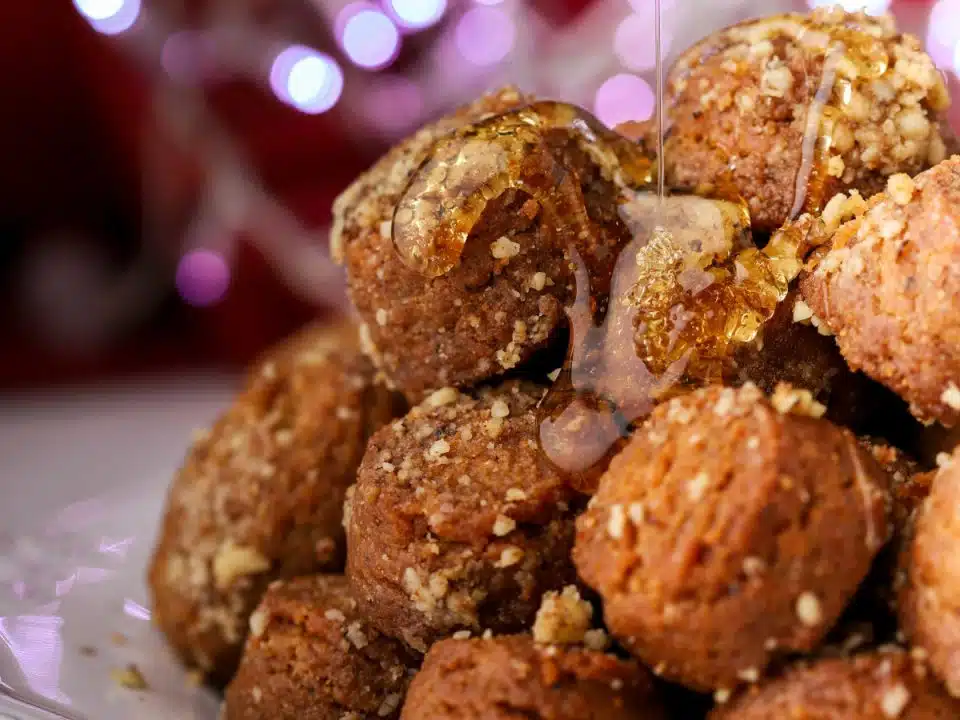
Greek honey cookies or melomakarona are the epitome of Christmas and holidays in Greece. They are soft and syrupy, as they are dipped in a spiced cinnamon and orange syrup after they are baked. They also have crushed walnuts sprinkled all over them to add that crunchy texture as well.
In some other variations of the cookies, you can find them filled with chocolate or chestnuts. No matter the type of melomakarona, you definitely are bound to find some on the Christmas dinner table.
20. Greek Almond Snowballs (Kourabiedes)
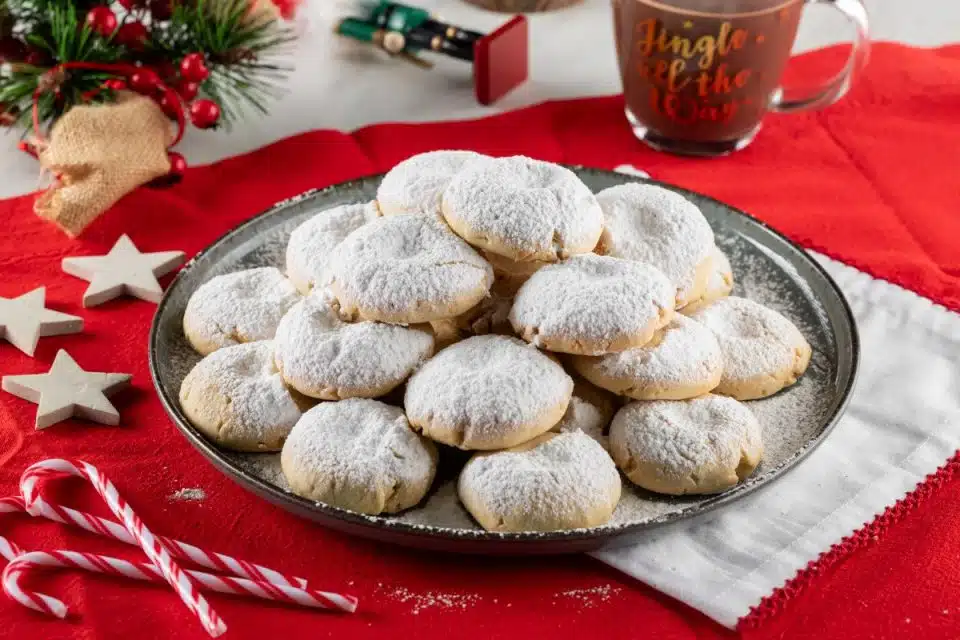
Kourabiedes go hand in hand with melomakarona, in the sense that you always find them in adjacent platters on the Christmas table. With regards to flavor and look, they are nothing alike. Kourabiedes are almond snowballs made out of flour, almonds, butter, sugar, a splash of almond liqueur, and a tad bit of rosewater.
The “snowball” part comes after they are baked and slightly cooled; that’s when copious amounts of icing sugar are dusted over them. As you might’ve already guessed, there is a debate every year on the Christmas table about which dessert is the best, melomakarona or kourabiedes. You’ll have to try them yourself if you want to have input!
Also check out our chocolate kourabiedes recipe, with added cocoa powder for an even better treat.
21. Greek Milk Pie (Galatopita)

Among the syrupy desserts, the light galatopita makes its presence known. It’s less sweet than melomakarona and kourabiedes for sure, yet still sweet enough to satisfy the dessert craving after a lavish Christmas feast.
The milky interior of the pie made out of butter, sugar, milk, cornstarch, semolina, and eggs is topped by a coat of sugar, lemon zest, water, and egg to make a crunchy overcoat; sort of like the French crème brûlée. At the end of the day, it’s simple, sweet, delicious, and makes for a very quick dessert served during the festive period.
22. Lalaggia

This one is an exceptional dessert found in the Mani Peninsula. They are also known as “the pancakes of Mani,” even though they look nothing like American pancakes. Instead, Lalaggia are more extended pieces of dough formed almost into a short rope shape and then deep fried. In Mani, they are served in various ways, including being topped with honey and walnuts or sugar and cinnamon. They’re almost kind of like the Greek Christmas version of churros, if you think about it!
23. Sweet Phyllo Pumpkin Pie

Once again, this is the Greek version for a very American dessert, even though it looks and tastes nothing like the classic pumpkin pie. Sweet phyllo pumpkin pie is a dessert served in the region of Epirus during the holidays, and it’s a very unique dish.
Of course, it’s made with layers of phyllo dough that are filled with grated pumpkin, semolina, sugar, cinnamon, cloves, and raisins or walnuts too, if you want. It’s very fragrant and subtly sweet, so much so that it is considered one of the lighter Christmas desserts.
24. Kormos (Yule Log)

Kormos is a dessert that has two different variations: the first one is made out of chocolate, cream, condensed milk, cocoa, and butter cookies. The butter cookies are crushed and folded into the chocolate mixture. Then, this is shaped into a log and stored in the fridge for at least six hours.
The other dessert is the yule log traditionally made out of sponge cake and chocolate ganache. Clearly, they are two different desserts, but they share the same name and are often found at the same chocolate lovers’ Christmas table!
25. Christopsomo
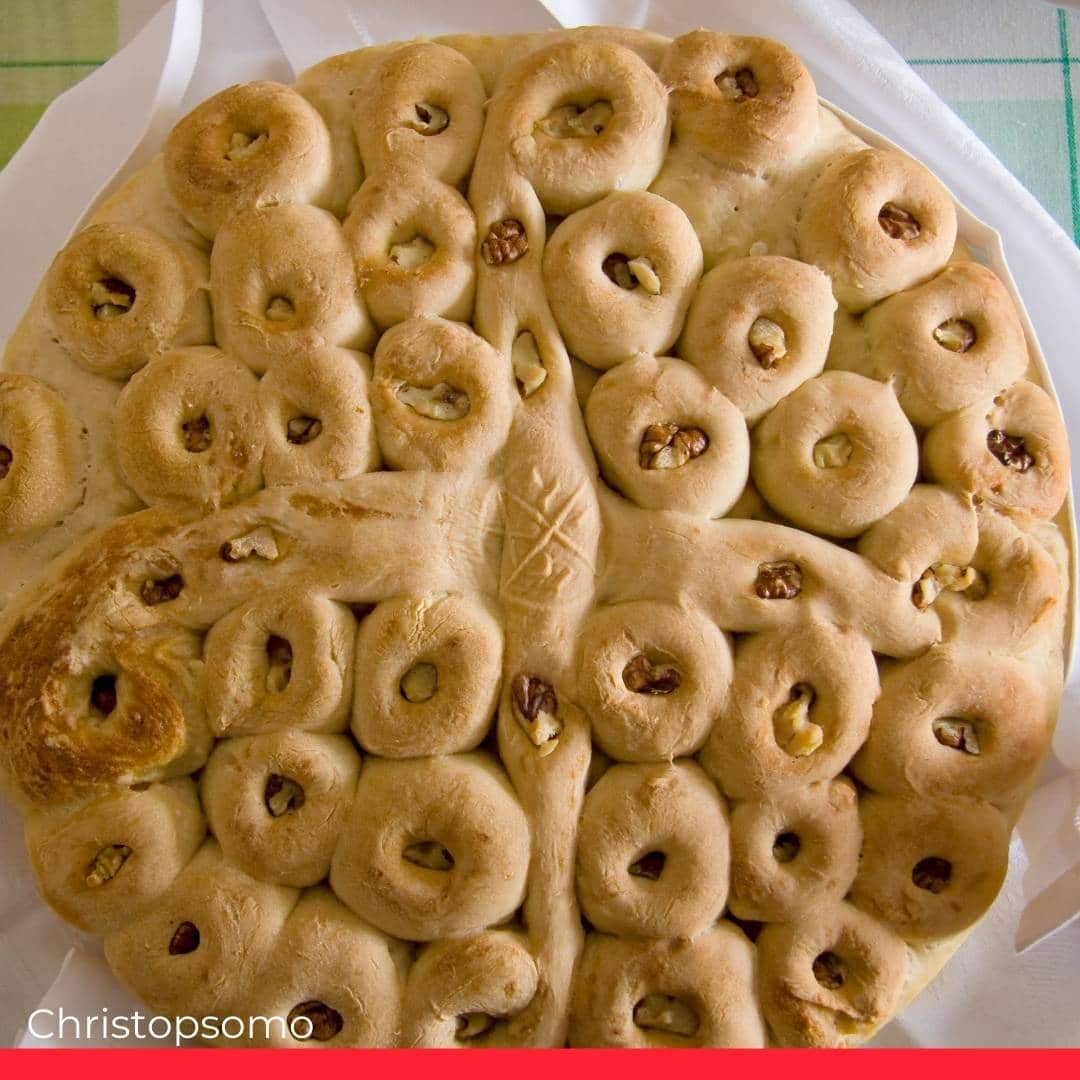
Last but definitely not least, the “Christopsomo” or Christmas Bread is a dessert/sweet bread hybrid that doesn’t go missing from any Christmas Eve dinner. In a way, it tastes a little bit like the Easter “Tsoureki,” yet it doesn’t look anything like it.
It always has a circular shape, and the simplest version of the bread has a cross made out of dough shaped overtop. The most intricate ones have symbols made out of dough on them that refer to the birth of Christ. Naturally, it’s usually huge, so everyone gets a piece and even seconds if they desire.
Related: Best Greek Desserts
Related: Most Popular Greek Cheeses
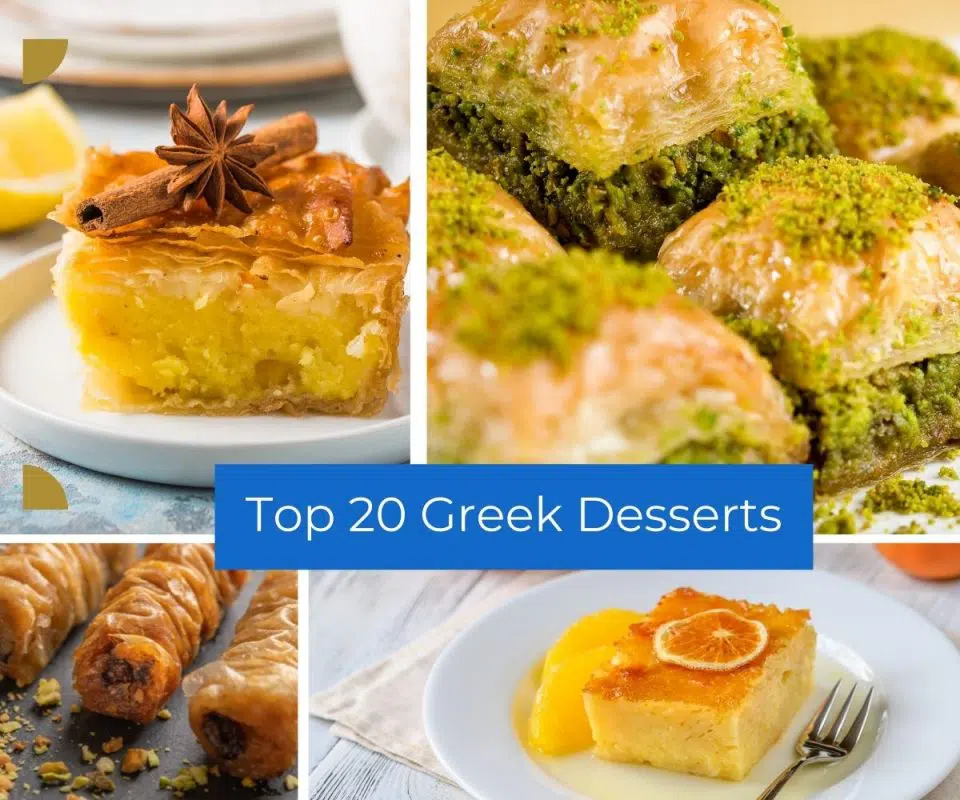
Related: 10 Popular Greek Cookies


